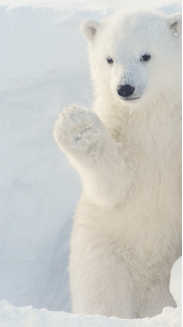Survival in the Arctic
What do you do when the cold winter comes? If you’re at home, you turn up the heater, or throw an extra blanket on your bed. If you have to go outside, you probably wear a thick sweater and a coat. But what about animals, especially the ones in the Arctic? Do they turn up the heater or wear thick coats? Not exactly! Animals have developed natural barriers to trap body heat. This allows them to survive in cold climates. It is as if they wear several “winter coats,” each of which plays an important part.
The first coat is often a layer of fat called blubber which is hidden under the skin. Blubber is a thermal insulator. It consists of fat, but it is different than the body fat caused by eating. It does not allow the cold to come in, or the heat of the body to go out. Blubber also can be used as a food reserve. The polar bear is an example of an animal which has blubber under its skin.
In addition, many arctic animals have special fur. For example, the polar bear’s thick fur protects their body from the cold quite well because their fur is also oily. The oily coating keeps the polar bear dry because the oil prevents water from reaching their body. It also keeps the heat in, so they can stay warm. This fur looks white from a distance. However, actually it is often transparent. The transparency adds an extra advantage. When the fur is transparent, the heat from the sun can go through it and reach the skin of the animals, which provides them with extra heat.
It is very interesting that some arctic animals, such as polar bears, as so well insulated that they cannot be spotted with night-vision goggles. Usually, if you’re wearing night-vision goggles, you can see an animal’s body heat even in the dark. However, you wouldn’t be able to see polar bears. The outer layer of their fur has the same temperature as their surroundings. In other words, these animals can keep all their heat inside, losing none to the environment. How amazing!

